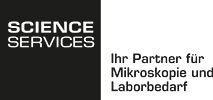Common Lead Stock Solutions
The following are some Lead Stock solutions, which are commonly used:
A. Lead Staining stock solution by Reynold’s (1963)
- In a 50 ml volumetric flask add: Lead Nitrate Pb(NO3)2 1.33 g Sodium Citrate Na3(C6H5O7).2H2O 1.76 g Boiled, cooled, CO2 free dist. water 30 ml
- Cover the flask. Shake vigorously for at least one minute.
- Add 8 ml of 1N NaOH CO2 free (EMS Cat. #21170).
- Mix until clear.
- Check the pH. It should be 12.0 ±0.1. If the pH is low add more NaOH to the clear solution. If the pH is above 12.1 start over this time adding a smaller amount of NaOH.
- Add CO2 free water to bring the solution to a final volume of 50 ml.
- Let stand several hours before use.
- Store in amber, tightly covered bottle in refrigerator.
B. Lead Staining Stock Solution by Venable and Coggeshall (1965)
- In 12 ml sample bottles (EMS Cat. #64254) add 0.01g - 0.04g Lead citrate (EMS Cat. #17800) to 10 ml CO2 free distilled water.
- Add 0.1 ml 10N NaOH. Cap the bottle and shake well until clear. To use, draw a small portion up with a syringe and use a syringe filter, or, centrifuge a small covered sample at 6000 rpm for 15 minutes.
NOTE: Removal of heavy metal precipitates (artifacts) Uranyl acetate (small, needle shaped), crystals or lead carbonate (large, spherical) is imperative. The reason being is these precipitates can obscure vital detail and the end result is poor quality micrographs. Kuo, et al (1981), suggested that these artifacts can often be removed by a 30 second dip into freshly prepared 10 % glacial acetic acid followed by two rinses in distilled water.




